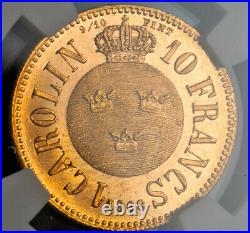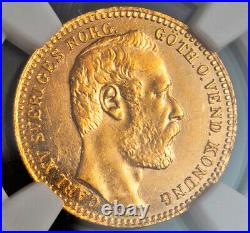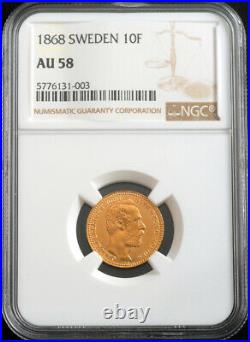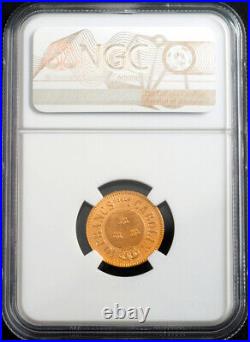




1868, Sweden, Charles XV. Beautiful Gold 10 Francs “Carolin” Coin. Mint Year: 1868 Mintage: 33,000 pcs. Engraver: Lea Ahlborn Mint Place: Stockholm Denomination: 10 Francs (Carolin). Certified and graded by NGC as AU-58! Reference: Friedberg 92, Ahlström 11, KM-733. 900 Diameter: 19mm Weight: 3.22gm. Obverse: Head of Charles XV as King of Sweden and Norway right. Of Lea Ahlborn below. Legend: CARL XV SVERIGES OCH NORG. KONUNG Reverse: Crowned globe with three crowns inside. Legend: 1 CAROLIN (9/10 FINT) 10 FRANCS (1868). She was a member of the Royal Swedish Academy of Arts, and the first woman to be appointed royal printmaker. The position of royal printmaker was public office, and thereby also made her the first female official in Sweden. She made the medal-portraits to the celebration of the anniversary of the wedding of the king and queen, and she was hired by the US government to make the medal of George Washington at the centenary (hundred years anniversary) of the end of the war of independence in 1883, and to the celebration of Christopher Columbus’ discovery of America in 1892. In 1892, she was given the medal Illis Quorum by the king. Charles XV & IV (Carl Ludvig Eugen) (3 May 1826 18 September 1872) was King of Sweden (as Karl XV) and Norway (as Karl IV) from 1859 until his death. Though known as King Charles XV in Sweden, he was actually the ninth Swedish king by that name, as his predecessor Charles IX (reigned 16041611) had adopted a numeral according to a fictitious history of Sweden. He was born in Stockholm Palace, Stockholm, and dubbed Duke of Skåne at birth. He was the eldest son of King Oscar I and Josephine of Leuchtenberg. He was given his first officer’s commission in 1841 by his grandfather, Charles XIV John. After his father’s accession to the throne in 1844, he was made a chancellor of the universities of Uppsala and Lund, and in 1853 chancellor of Royal Swedish Academy of Arts. On February 11, 1846, he was made an honorary member of the Royal Swedish Academy of Sciences. The Crown Prince was Viceroy of Norway briefly in 1856 and 1857. He became Regent on 25 September 1857, and king on the death of his father on 8 July 1859. On 19 June 1850 he married in Stockholm Louise of the Netherlands, niece of William II of the Netherlands through her father and niece of William I of Prussia, German Emperor, through her mother. The couple were personally quite dissimilar; Princess Louise was in love with her husband, whereas he preferred other women. His well-known mistresses included the countess Josephine Sparre and the actresses Hanna Styrell and Elise Hwasser, the latter the most celebrated actress in Sweden during his reign, and the Crown Prince neglected his shy wife. On the other hand, his relationship to his only daughter, Louise, was warm and close. As Crown Prince, Charles’ brusque manner led many to regard his future accession with some apprehension, yet he proved to be one of the most popular of Scandinavian kings and a constitutional ruler in the best sense of the word. His reign was remarkable for its manifold and far-reaching reforms. Sweden’s existing communal law (1862), ecclesiastical law (1863) and criminal law (1864) were enacted appropriately enough under the direction of a king whose motto was. Land skall med lag byggas. “With law shall the land be built”. Charles also helped Louis De Geer to carry through his memorable reform of the Riksdag in 1866. He also declared the freedom of women by passing the law of legal majority for unmarried women in 1858 – his sister Princess Eugenie became the first woman who was declared mature. Charles was an advocate of Scandinavianism and the political solidarity of the three northern kingdoms, and his friendship with Frederick VII of Denmark, it is said, led him to give half promises of help to Denmark on the eve of the war of 1864, which, in the circumstances, were perhaps misleading and unjustifiable. In view, however, of the unpreparedness of the Swedish army and the difficulties of the situation, Charles was forced to observe a strict neutrality. He died in Malmö on 18 September 1872. Charles XV attained some eminence as a painter and as a poet. He was followed on both the thrones of Norway and Sweden by his brother Oscar II. In 1855 he became the 990th Knight of the Order of the Golden Fleece in Spain. A few weeks before Charles’ death, his daughter Louise (then the Crown Princess of Denmark) gave birth to her second son. The young Prince of Denmark became christened as grandfather Charles’ namesake. In 1905 this grandson, Prince Carl of Denmark, ascended the throne of Norway, becoming thus his maternal grandfather’s successor in that country, and assumed the reign name Haakon VII. The present king, Harald V of Norway, is Charles’ great-great-grandson, through his father and mother. No subsequent king of Sweden to this day is Charles’ direct descendant. However, his descendants are or have been on the thrones of Denmark, Luxembourg, Greece, Belgium and Norway. The item “1868, Sweden, Charles XV. Beautiful Gold 10 Francs Carolin Coin. NGC AU-58″ is in sale since Saturday, November 21, 2020. This item is in the category “Coins & Paper Money\Coins\ World\Europe\Sweden”. The seller is “coinworldtv” and is located in Wien. This item can be shipped worldwide.
- Composition: Gold
- Country/Region of Manufacture: Sweden
- Certification: NGC
- KM Number: 733
- Grade: AU 58
- Year: 1868

